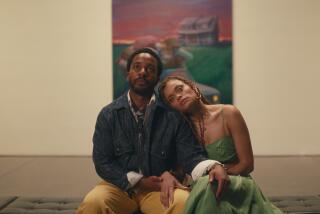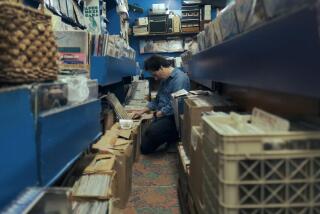Warhol in his followers’ eyes
- Share via
I wouldn’t have lasted even 15 minutes in Andy Warhol’s famous Factory, being of a retiring and abstemious nature and possessing not even the glamour of a Ken doll. But I’ve had my nose pressed to the window of that studio/salon/scene ever since I fell in love with the Velvet Underground (the Factory house band). There are a lot of us peeking in.
The latest retelling of this oft-told tale, set at the intersection of art and life, is “Andy Warhol’s Factory People,” a three-part documentary series that begins tonight on Ovation TV (self-described as “the only network dedicated to art, culture and creativity”). It’s part of a “programming event” that also includes the biopics “Basquiat,” in which David Bowie plays Warhol, and “I Shot Andy Warhol,” featuring my favorite fake Andy, Jared Harris; documentaries on Velvets Lou Reed and John Cale; and tangentially relevant films on artists Jeff Koons and Ray Johnson (the excellent “How to Draw a Bunny”). On Thanksgiving Day, “Factory People” will play all day long, a Warholian thing to do. And Thanksgiving is appropriate, as this is a story more than anything about family.
What makes this Warhol documentary, directed by Catherine O’Sullivan Shorr, slightly different from other Warhol documentaries is its avowed bottom-up approach: Warhol as a function of his followers is the idea. (“Factory People” assumes you already know your Andy.) Of course, this is true to some degree of any film about this artist, given the fact that he’s no longer around to speak for himself, and even when he was he preferred utterance to explication, and also given the use he made of those around him. But this time the interview subjects get to talk about themselves, and each other, a little more than usual.
There are lots of photos and film clips, both by and of Warhol -- who would have turned 80 this year -- but it’s the interviews, most of them new, that that tell the tale. There are Warhol assistant Gerard Malanga, unofficial Factory foreman Billy Name, biographer Victor Bockris (who calls the Factory “the most intelligent art commune in the world”), “superstars” Ultra Violet, Mary Woronov and Holly Woodlawn, actors Allen Midgette and Taylor Mead, and Velvets Reed and Nico.
There is naturally some disagreement among the subjects, especially given the passage of 40 years, but the Factory seems to have anyway been a place of contradiction. Warhol’s own disinclination to set down rules or adjudicate disputes left his helpers and hangers-on -- the young, the restless and the formerly institutionalized, the “disinherited people like me” in Mead’s words -- to sort things out for themselves, not always successfully. (There were more than a few suicides among them.) It was a place of refuge where everyone was tested; a party where work got done. (“It was really very tedious,” says Woronov of Factory life.) Warhol is portrayed here, as elsewhere, as double-natured: a lazy workaholic, a passive manipulator, a generous skinflint. His nickname, “Drella,” combined Cinderella and Dracula.
The film lacks poetry somewhat -- it’s never as evocative as, say, a song by the Velvet Underground, whose sound is borrowed for the soundtrack -- but the images keep their glamour. Most successfully, “Factory People” is a picture of bohemians in their age. Some have fared better than others, but a remarkable many have survived to remember: It was the best of times, it was the worst of times, the film and its subjects say -- but anyway, it was a time.
--
--
‘Andy Warhol’s Factory People’ (Parts 1, 2 and 3)
Where: Ovation TV
When: 5 and 8 p.m. today, Tuesday and Wednesday
Rating: Not rated
More to Read
The complete guide to home viewing
Get Screen Gab for everything about the TV shows and streaming movies everyone’s talking about.
You may occasionally receive promotional content from the Los Angeles Times.







